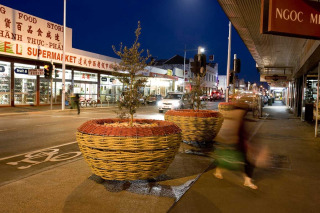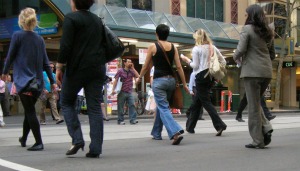Urban planning
"Artists, philosophers, urban planners and architects have been dreaming, writing about and drawing 'ideal cities' for hundreds of years...In most of these visions the pedestrian is the measure of ideal urban spaces." (Pedestrians' Quality Needs, p.34)
What makes a walkable environment?

There is an extensive body of research that explores the different types of policy interventions and built form characteristics that promote walking. Some useful summaries include:
- Travel and the Built Environment (Ewing and Cervero 2010), provides a quantitative analysis of more than 50 other studies on the built environment.
- The Walking and Cycling International Literature Review prepared for the Victorian Department of Transport (Krizek, Forsyth and Baum 2009).
Some of the key conclusions to be drawn from this research include:
- Destination accessibility - making sure there are places to walk to within walking distance - is probably the most important factor. This includes availability of public transport, which is strongly associated with walking.
- Connectivity and permeability in the walking network is very important - intersection density is one of the most important measurable indicators of a walkable environment.
- The availability and cost of car parking is a key factor in determining how people travel.
- Higher density development provides an opportunity for more people to live in walkable areas and provides the customers required to sustain local business - providing walkable destinations.
- Proximity to the CBD is strongly associated with walking, perhaps reflecting the fact that inner city areas tend to be more walkable.
- The quality of walking infrastructure - footpaths, crossings, etc - is important for less mobile groups such as seniors, disabled people, children and their parents. Perceptions of infrastructure may be as important as the reality.
- The aesthetic quality of the built environment is significant, but hard to quantify.
- The street environment must feel safe.
- Factors beyond the built environment, such as attitudes and personal preferences, are also important determinants of walking.
The desirability of walkability

There is every indication that people want to live in walkable suburbs. The Heart Foundation publication Creating Healthy Neighbourhoods reports on a Newspoll survey of 1,400 adults in Sydney, Melbourne, Brisbane, Adelaide and Perth, on their preferences when deciding where to live. Key findings were:
- More than 50% of people indicated that every street in the area having a paved or concreted footpath would be extremely or very important to them.
- Almost 70% of people rated being within easy walking distance of public transport as extremely or very important.
- 64% of people said that being within easy walking distance to a range of local services would be extremely or very important to them when deciding where to live.
The desirability of walkability is also illustrated by the higher land values of walkable areas.
Urban design resources

There is a multitude of information available on urban design, most of it generalist - how to design for walking, cycling and public transport, amongst other things.
The main local resources are set out below.
- Urban Design Guidelines for Victoria.
- The Heart Foundation's Healthy by Design provides a good summary of the key elements of design for active transport and is written for Victorian planners.
- Creating Places for People sets out the national Urban Design Protocol and links to other resources.
- Healthy Spaces & Places, a collaboration between the Heart Foundation, Planning Institute and Local Government Association, provides extensive material.
It should be noted that the design requirements for walking and cycling are not the same. The Walking and Cycling International Literature Review (link above) explains their different needs. In many ways walking has a stronger relationship with public transport than cycling.
The remaining pages of this section look at elements of walkable planning and design in more detail. For walkable design in road environments, see the road management section of this site.